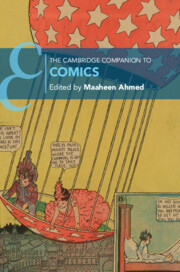Book contents
- The Cambridge Companion to Comics
- The Cambridge Companion to Comics
- Copyright page
- Contents
- Figures
- Contributors
- Acknowledgments
- Chronology
- Introduction
- Part I Forms
- Part II Readings
- Part III Uses
- Chapter 13 Comics and Their Archives
- Chapter 14 Readers and Fans
- Chapter 15 Comics in the Museum
- Chapter 16 Comics in Libraries
- Chapter 17 “Educationally Occupied”
- Further Reading
- Index
- Cambridge Companions To …
- References
Chapter 13 - Comics and Their Archives
from Part III - Uses
Published online by Cambridge University Press: 17 August 2023
- The Cambridge Companion to Comics
- The Cambridge Companion to Comics
- Copyright page
- Contents
- Figures
- Contributors
- Acknowledgments
- Chronology
- Introduction
- Part I Forms
- Part II Readings
- Part III Uses
- Chapter 13 Comics and Their Archives
- Chapter 14 Readers and Fans
- Chapter 15 Comics in the Museum
- Chapter 16 Comics in Libraries
- Chapter 17 “Educationally Occupied”
- Further Reading
- Index
- Cambridge Companions To …
- References
Summary
As popular print ephemera, comics hold a complex and precarious relationship to preservation and duration, which has marked their status as “archivable” (or “non-archivable”) materials. This chapter sketches some of the different ways that institutions, producers, and audiences have coped with this fragility and have defined practices of preservation and collection. The chapter subsequently analyzes comics in libraries and archives, collecting practices by readers and fans, uses of archives in comics production. At each step, it pays particular attention to the importance of materiality, senses, formats, manipulation in the preservation of comics, connecting them to matters of copyright, library policies, and commercial interests. The importance of these parameters is set out against changing notions of archives and archival practice, especially under the impulse of their digital transformation. The broader picture considers the importance of medium specificity in an age of online archival plenitude.
Keywords
- Type
- Chapter
- Information
- The Cambridge Companion to Comics , pp. 267 - 286Publisher: Cambridge University PressPrint publication year: 2023



